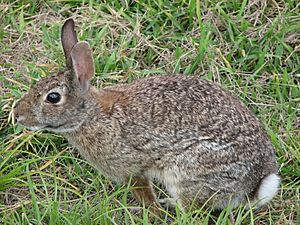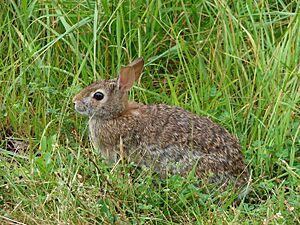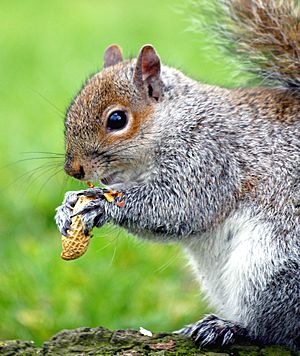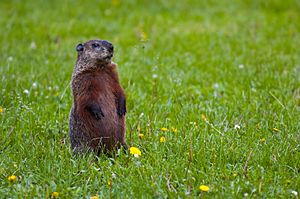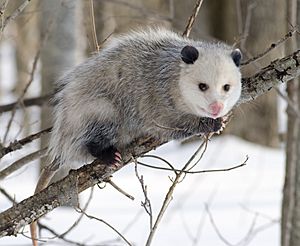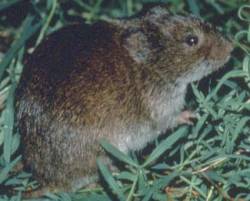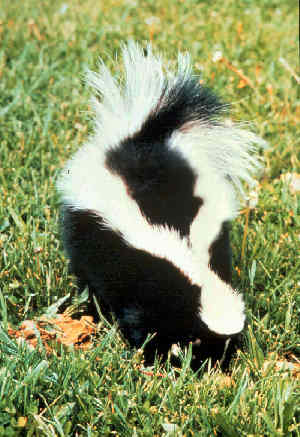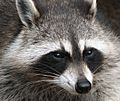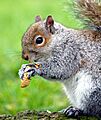Mammals of the Indiana Dunes facts for kids
Thirty-seven different kinds of mammals live in Indiana Dunes National Park. Scientists think four more might live there, but they haven't seen them yet. These include the northern long-eared myotis, the Indiana bat, the hoary bat, and the southern bog lemming.
Some mammals you might often see are the eastern cottontail rabbit, the eastern fox squirrel, the white-footed mouse, the white-tailed deer, and the meadow vole. Sadly, some mammals that used to live here are now gone from the area. These include the common porcupine, the wolf, the red wolf, the black bear, the fisher, the North American river otter, the cougar, the Canada lynx, the bobcat, the elk, and the American bison.
There are also two special species in the dunes that need protection. The American badger is on Indiana's threatened list, meaning it could become endangered. The Indiana bat is on the federal endangered list, which means it's in danger of disappearing forever. Scientists believe it lives in parts of the dunes.
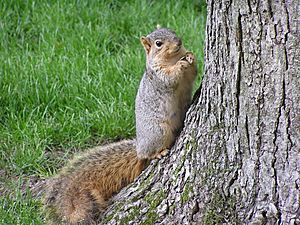
Contents
- Mammals You Can Find in the Dunes
- Mammal Habitats in the Dunes
- Lowland Forest: Forests in Lower Areas
- Wetlands: Water-Filled Areas
- Developed Areas: Human-Affected Habitats
- Images for kids
Mammals You Can Find in the Dunes
Here's a list of some of the mammals that have been officially seen and recorded in the Indiana Dunes.
| Common Name | Latin Name |
|---|---|
| Virginia opossum | Didelphis virginiana |
| Masked shrew | Sorex cinereus |
| Northern short-tailed shrew | Blarina brevicauda |
| Least shrew | Cryptotis parva |
| Eastern mole | Scalopus aquaticus |
| Short-tailed shrew | Blarina brevicauda |
| Little brown bat | Myotis lucifugus |
| Eastern red bat | Lasiurus borealis |
| Silver-haired bat | Lasionycteris noctivagans |
| Big brown bat | Eptesicus fuscus |
| Red bat | Nycteris borealis |
| Eastern cottontail | Sylvilagus floridanus |
| Eastern chipmunk | Tamias striatus |
| Woodchuck | Marmota monax |
| Thirteen-lined ground squirrel | Spermophilus tridecemlineatus |
| Eastern gray squirrel | Sciurus carolinensis |
| Eastern fox squirrel | Sciurus niger |
| American red squirrel | Tamiasciurus hudsonicus |
| Southern flying squirrel | Glaucomys volans |
| American beaver | Castor canadensis |
| White-footed mouse | Peromyscus leucopus |
| Northern deer mouse | Peromyscus leucopus noveboracenis |
| Prairie deer mouse | Peromyscus maniculatus bairdii |
| Brown rat | Rattus norvegicus |
| House mouse | Mus musculus |
| Prairie vole | Microtus ochrogaster |
| Meadow vole | Microtus pennsylvanicus |
| Woodland vole | Microtus pinetorum |
| Common muskrat | Ondatra zibethicus |
| Meadow jumping mouse | Zapus hudsonius |
| Coyote | Canis latrans |
| Red fox | Vulpes vulpes |
| Common gray fox | Urocyon cinereoargenteus |
| Common raccoon | Procyon lotor |
| Long-tailed weasel | Mustela frenata |
| Least weasel | Mustela nivalis |
| American mink | Neovison vison |
| American badger | Taridea taxus |
| Striped skunk | Mephitis mephitis |
| White-tailed deer | Odocoileus virginianus |
Mammal Habitats in the Dunes
The Indiana Dunes National Park has many different types of places where animals live, called habitats. These habitats are always changing! For example, old neighborhoods are slowly turning back into wetlands or savannas. Even places like Mount Baldy are changing from forests to open sand. This means that the animals living there might have to find new homes over time.
Barren Ground: Open Sand Areas
Barren ground means open sand, like on the beaches and in big sandy holes called blowouts. These areas make up about 4% of the dunes. Not many plants grow here, so no mammals live here all the time. Animals usually visit the beach at night to find food or water. In blowouts, you might find signs of mammals near small groups of plants.
Animals found here:
- Beaches: Virginia opossum, raccoon, prairie deer mice, and white-tailed deer.
- Blowouts: Masked shrew, prairie vole, and meadow voles.
Prairie: Grassy Open Spaces
About 4.4% of the dunes area is prairie, which is mostly open grassland. Most of it is dry prairie, and a smaller part is wet prairie.
Dry Prairie: Sandy Grasslands
Dry prairies are usually found near the front of the dunes. You can spot them by their open sand mixed with grasses like marram grass and sand reed. More plants here mean more places for small mammals to hide. Sometimes, little bluestem grass grows in thick patches, which can attract even more types of plants and animals.
Animals found here:
- In areas with marram grass, sand reed, and little bluestem: Prairie deer mice, white-footed mice, meadow voles, thirteen-lined ground squirrels, northern short-tailed shrews, and eastern cottontails. Prairie mice are special because their numbers go up when there's less plant cover. Voles, however, need lots of plants to do well.
- In areas with only marram grass and sand reed: Prairie deer mice, white-footed mice, prairie voles, ground squirrels, eastern cottontails, and northern short-tailed shrew.
- In areas mostly covered by little bluestem grass: Prairie deer mice, white-footed mice, northern short-tailed shrews, thirteen-lined ground squirrels, and eastern cottontail.
You might also see signs of eastern cottontails, red foxes, white-tailed deer, domestic dogs, and long-tailed weasels. Scientists have seen signs that might be from the southern bog lemming, but they haven't found the animal itself yet.
Wet Prairie: Damp Grasslands
Wet prairies have shrubs like willow, aspen, and oak. Common grasses include reed canary grass and blue joint grass. You might also see cattails and rushes. Animals can easily hide in the thick plants here.
Animals found here: The masked shrew is very common. Meadow voles, white-footed mice, and northern short-tailed shrews are also found in large numbers. Other mammals include prairie deer mice, common raccoons, and meadow jumping mouses. Signs of eastern moles, woodchucks, and white-tailed deer have also been seen.
Terrestrial Shrubland: Bushy Areas
There aren't many large shrublands in the dunes. Instead, you'll find bushy areas between the grassy dunes and the forests. These areas have young oaks, conifers, basswood, and other plants like grape vines, cherry trees, and bearberry bushes.
Lowland Terrestrial Shrubland: Wet Bushy Areas
This habitat can be thickets of willow, red maple, or aspen. Some of these areas used to be sand mines that are now turning back into dry prairie, with patches of little bluestem grass or red osier dogwood.
Animals found here: No single mammal species is super common here. You might find white-footed mice, northern short-tailed shrews, thirteen-lined ground squirrels, Virginia opossums, common raccoons, woodchucks, red squirrels, and meadow voles. Signs of eastern cottontails, white-tailed deer, and eastern moles can also be seen. Animals often just pass through these areas as the habitat changes.
Upland Terrestrial Shrubland: Disturbed Bushy Areas
These are disturbed areas found between old grassy fields or savannas and wooded areas.
Animals found here: You'll find meadow voles and shrews here, which are leftovers from when these areas were fields. In the bushier parts, there are many animals, from small to large, including meadow voles, short-tailed shrews, white-footed mice, raccoons, masked shrews, prairie deer mice, prairie voles, and meadow jumping mouses. Signs of white-tailed deer, eastern cottontails, eastern chipmunks, eastern fox squirrels, domestic dogs, and red foxes have also been found.
Savanna: Grasslands with Scattered Trees
The dunes have three types of savanna, which are grassy areas with scattered trees. Oak savanna is the most common.
Oak Savanna: Grassy Areas with Oak Trees
Oak savannas are grassy areas with scattered black oak trees. It can be hard to tell them apart from black oak forests. The forest has a full roof of black oak trees, while the savanna has more open spaces. The plants underneath the trees can vary, including young oak trees, blackberry bushes, blueberry bushes, rose bushes, and Japanese honeysuckle.
Animals found here: The white-footed mouse is the most common mammal. Prairie deer mice prefer open, dry areas, while white-footed mice live in many different habitats, including savannas. Other animals found here include masked shrews, thirteen-lined ground squirrels, eastern chipmunks, southern flying squirrels, and common raccoons. You might also see white-tailed deer, eastern moles, woodchucks, eastern fox squirrels, eastern cottontails, and eastern gray squirrels.
Coniferous Savanna: Pine and Oak Areas
There's only a small strip of coniferous savanna, found between the grassy dunes and the black oak dunes. It has jack pine trees and a few black oaks. The bushes here are very thick, providing great hiding places. Bearberry and little bluestem grass are the main plants.
Animals found here: The white-footed mouse is very common. Other animals include Virginia opossums, thirteen-lined ground squirrels, muskrats, white-tailed deer, eastern cottontails, prairie deer mouses, meadow voles, red foxes, and raccoons. White-footed mice like wooded areas, while prairie deer mice prefer open, dry spots. Meadow voles and muskrats are found in wet areas with lots of cover.
Mixed Deciduous Savanna: Cottonwood and Grass Areas
These savannas have scattered eastern cottonwood trees mixed with little bluestem grass. Other grasses and shrubs like grape, sumac, and bearberry are also present. This habitat offers lots of hiding spots for small animals.
Animals found here: The white-footed mouse is very common, along with northern short-tailed shrews, prairie deer mice, meadow voles, and raccoons.
Upland Forest: High Ground Forests
Upland forest is the largest habitat in the park. It includes upland oak forest, mixed deciduous forest, and coniferous forest.
Upland Oak Forest: Oak Tree Dominance
Oak forests blend into oak savannas and together make up a big part of the park. Black oaks grow on higher, drier spots, and red oaks are found in lower, wetter areas between the dunes. The shrub layer is often thick and diverse, with young oak trees and blueberry bushes.
Animals found here: The white-footed mouse, northern short-tailed shrews, eastern gray squirrels, eastern chipmunks, and southern flying squirrels are common. You might also see signs of white-tailed deer, eastern moles, eastern fox squirrels, gray foxes, long-tailed weasels, and eastern skunks.
Upland Coniferous Forest: Pine and Fir Forests
Conifer trees (like pines) don't live very long in the dunes. They grow for a short time before oak forests take over.
Animals found here: The white-footed mouse, northern short-tailed shrews, eastern gray squirrels, eastern chipmunks, and southern flying squirrels. Signs of white-tailed deer, eastern chipmunks, eastern fox squirrels, eastern moles, gray foxes, long-tailed weasels, eastern raccoons, and eastern cottontails have been seen.
Upland Mixed Deciduous Forest: Diverse Tree Mix
These forests have a mix of oaks (black, red, white, and pin) and maples (red and silver). Some areas are beech-maple forests. Other trees like cherry, ash, and elm are also found. The ground cover can be thin or thick.
Animals found here: The most common animal is the white-footed mouse. Other mammals include the common raccoon, northern short-tailed shrews, Virginia opossum, meadow vole, woodchuck, red squirrel, eastern mole, eastern fox squirrel, and the white-tailed deer.
Lowland Forest: Forests in Lower Areas
These forests are found in lower areas, often with more moisture.
Ephemeral Lowland Forest: Forests with Temporary Water
These lowlands have a thick layer of leaves from many different trees. Silver or red maple trees are common, along with oak, ash, aspen, and sassafras. The shrubs can be packed closely or spread out. Spicebush is common.
Animals found here: white-footed mice, northern short-tailed shrews, eastern chipmunks, common raccoons, long-tailed weasels, red squirrels, masked shrew, eastern cottontails, meadow voles, woodchucks, and white-tailed deer. You might also see eastern moles.
Perennial Lowland Forest: Forests with Year-Round Water
These forests stay wet for at least six months each year. The plants here vary a lot. Maples are common, followed by pin oak, black oak, aspen, elm, birch, and wild black cherry. The ground layer often has grasses and ferns, often growing in clumps on small mounds.
Animals found here:
The white-footed mouse is very common, along with raccoons, northern short-tailed shrews, eastern chipmunks, Virginia opossums, masked shrews, meadow voles, woodchucks, and eastern fox squirrels. White-tailed deer and chipmunks are also found. There's also evidence of red squirrels, eastern moles, domestic dogs, and eastern cottontails.
Scientists think the star-nosed mole might be here too, based on burrows they've seen nearby.
Wetlands: Water-Filled Areas
The dunes have many different types of wetlands, including marshes, aquatic shrublands, swamps, and bogs.
Marsh: Grassy Wet Areas
Marsh habitats include the Great Marsh, where many muskrats live. Much of the marsh is covered in cattails, bulrushes, and sedges. Some marshes, like Cowles Bog, have floating mats of plants, similar to bogs.
Animals found here: The masked shrew, the white-footed mouse, and the meadow vole are all very common. The northern short-tailed shrew, the raccoon, and the white-tailed deer are also frequently seen. Other animals include the eastern cottontail, the eastern chipmunk, the woodchuck, the prairie vole, the common muskrat, and the long-tailed weasel. Muskrats are especially common near open water.
Aquatic Shrublands: Bushy Water Areas
These areas have very few tall trees, mostly oaks. The shrubs are usually aspen, willow, or oak. The ground is covered by blue joint grass or cattails.
Animals found here: The northern short-tailed shrew, the white-footed mouse, and the meadow vole are the most common mammals. The meadow jumping mouse is the largest single species found here. Eastern cottontails, prairie voles, common raccoons, and white-tailed deer are also present.
Swamp: Wet, Wooded Areas
Only a small part of the park (about 1%) is swamp. The trees are a mix of eastern cottonwood or black willow. The lower layers have willows, blackberries, or grapevines. The ground is thickly covered with blue joint grass, sedges, and cattails.
Animals found here:
Since much of the swamp is water, smaller animals like meadow voles and white-footed mice are found. Common raccoons and fox squirrels also live here. Signs of eastern cottontails have been seen. Older studies also found masked shrews and northern short-tailed shrews in the swamps.
Bogs: Spongy, Acidic Wetlands
Pinhook Bog and Cowles Bog are both bogs, which are wet, spongy areas with poor drainage. They often have mats of Sphagnum moss. Special plants like pitcher plants, sundews, cotton grass, and poison sumac grow here. The edges of bogs are often lined with tamarack trees.
Animals found here: The white-footed mouse is the only mammal found in more than one study area. Other species include northern short-tailed shrews, eastern cottontails, eastern chipmunks, and common raccoons. In older studies, masked shrews, meadow jumping mice, meadow voles, and house mice were also found.
Pannes: Wet Depressions Between Dunes
Between the sand dunes, right behind the beach, are shallow dips called pannes. These low spots can hold water for most of the year and are surrounded by grass and shrubs. Pannes are open, without tall trees. The edges have thick shrubs like red osier dogwood, willow, and Kalm's St. John's wort. The ground cover is excellent for hiding, especially in summer and fall.
Animals found here: The meadow vole is the only species found regularly. white-footed mice and prairie deer mice are also found, but never in the same panne. Larger animals include the Virginia opossum and the northern short-tailed shrew.
Developed Areas: Human-Affected Habitats
These are areas that have been changed by human activities.
Razed Residential Areas: Former Neighborhoods
These are areas where houses used to be, but are now being reclaimed by nature. They have scattered eastern cottonwood trees, with some maple, elm, and ash. The shrubs are thin but include young trees and bushes like wild and multiflora rose, Japanese honeysuckle, blackberry, grape, and red osier dogwood. The ground cover is fair to excellent, with grasses, goldenrods, and asters. There isn't a well-established mammal community here yet.
Animals found here:
The white-footed mouse is the most common mammal. Other mammals include the raccoon, northern short-tailed shrew, eastern mole, meadow vole, woodchuck, eastern fox squirrel, striped skunk, and white-tailed deer.
Rights-of-Way: Along Roads and Trails
Rights-of-way are areas along roads, railroads, or bike trails. These areas can disturb different types of habitats. They usually don't have many tall trees. The shrub layer can be thin or thick, often with blackberries, roses, grapes, Japanese honeysuckle, and sumac. Many different plants grow on the ground.
Animals found here: The eastern cottontail and the white-tailed deer are common. Other mammals include the meadow vole, woodchuck, and the prairie deer mouse. These animals are common in areas with less ground cover. You might also find the eastern mole, white-footed mouse, eastern fox squirrel, prairie vole, and meadow jumping mouse.
Excavated Areas: Human-Dug Spots
Excavated areas are places where humans have dug up the ground, leaving open sand. These spots don't have tall trees and have poor plant cover, with scattered grasses like little bluestem grass, sand reed, and nodding wild rye. Other areas might have Joe-Pye weed, bulrush, and spikerush.
Animals found here: Few animals use this habitat, mostly meadow voles and common raccoons. It's not a great place for mammals to live. Animals that might pass through include the Virginia opossum, the eastern mole, woodchuck, prairie deer mouse, red fox, and white-tailed deer.
Images for kids
-
Fox squirrel (Sciurus niger)


